The blue acara (Andinoacara pulcher) has been a beloved choice among aquarists for many generations, earning its place as one of the most popular cichlid species from South America. This popularity is well-deserved, as the name “pulcher” is derived from Latin, meaning “beautiful,” a fitting tribute to the fish’s striking appearance. The blue acara’s vibrant colors and engaging personality have made it a favorite among both novice and experienced fish keepers.
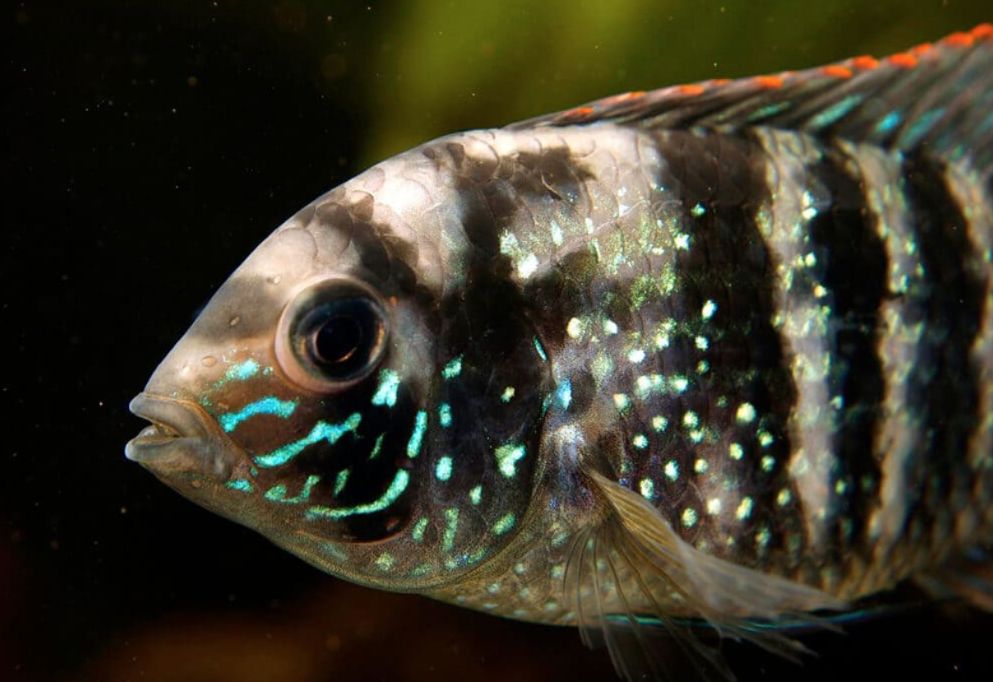
Contents
Habitat in the wild
The blue acara (Andinoacara pulcher) was first described in 1858 and is native to Central and South America, including Colombia, Venezuela, and Trinidad. This cichlid thrives in both flowing and stagnant waters, where it feeds on insects, invertebrates, and various small juveniles.
In their natural habitat, blue acaras are commonly found in areas with dense vegetation, submerged tree roots, and rocky formations. They favor environments with sandy or muddy substrates, which allow them to dig and create burrows for breeding and shelter.
The water in these regions is typically warm, with temperatures ranging from 75-82°F (24-28°C). The pH levels are usually slightly acidic to neutral, and the water hardness varies from soft to moderately hard.
Due to their popularity in the aquarium trade, blue acaras have been introduced to various regions outside their native range. In these new environments, they may adapt to different water conditions and habitats, which can impact local ecosystems.
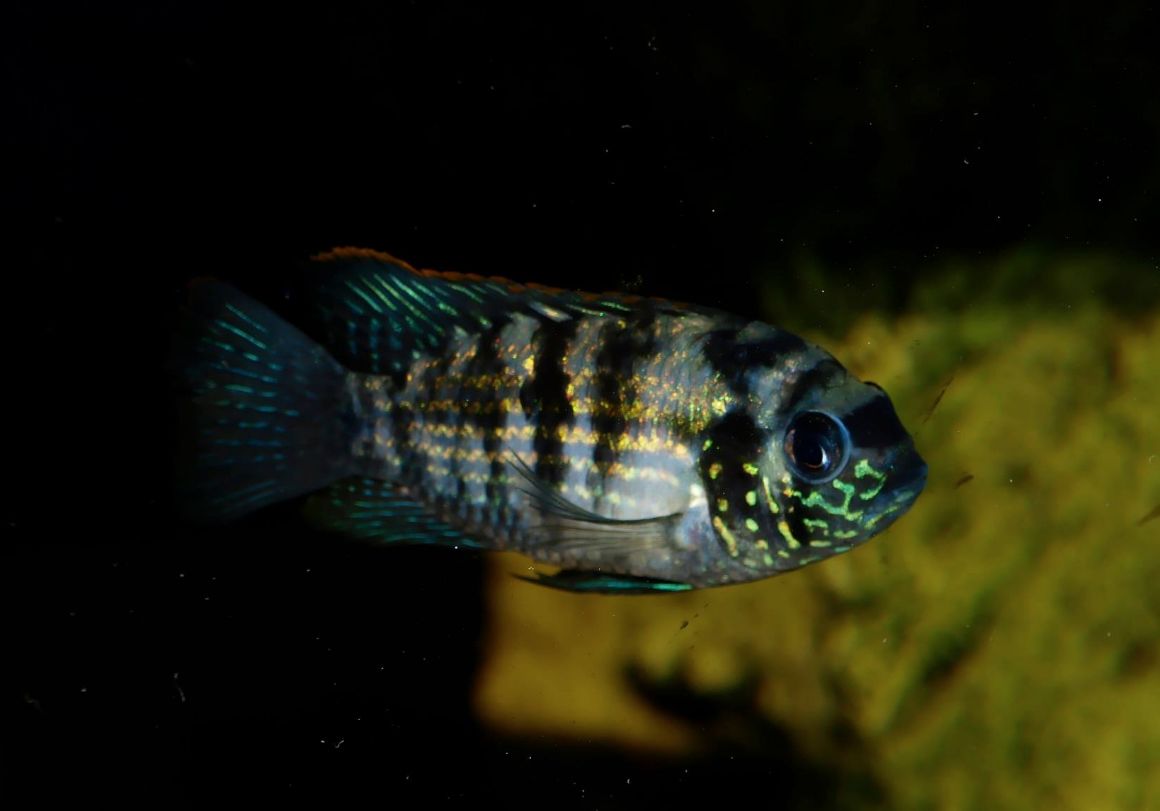
| Characteristic | Description |
|---|---|
| Scientific Name | Andinoacara pulcher |
| Common Names | Blue Acara, Electric Blue Acara |
| Origin | Central and South America |
| Adult Size | 6-8 inches (15-20 cm) in length |
| Coloration | Vibrant metallic blue with golden hues on face and belly |
| Body Shape | Laterally compressed with a deep oval shape |
| Temperament | Generally peaceful, can become territorial during breeding |
| Aquarium Requirements | Spacious tank, plenty of hiding spots, soft to moderately hard water, temperature range of 75-82°F (24-28°C) |
| Diet | Omnivorous, accepts high-quality pellets/flakes, supplemented with live/frozen foods (brine shrimp, bloodworms, small crustaceans) |
| Breeding | Monogamous, pair-forming, choose flat surfaces for spawning, both parents guard and care for fry |
| Compatibility | Generally compatible with peaceful community fish, avoid aggressive or territorial species |
Blue acara and electric blue acara
Recently, the electric blue acara (Nannacara sp. “electric blue”) has gained increasing popularity among aquarists. Although the terms “blue acara” and “electric blue acara” are often used interchangeably, they refer to different color morphs of the same species, Andinoacara pulcher.
The electric blue acara stands out due to its striking, intense blue coloration that covers the entire body, reminiscent of the vibrant hues seen in flower horn Thai silk. This selectively bred variant of the blue acara showcases a more vivid and solid blue shade, without the golden hues that can appear in the standard blue acara.
It’s important to understand that the electric blue acara is not a separate species but a color morph of the blue acara. Both variants share similar care requirements, behaviors, and characteristics, with the main difference being their coloration.

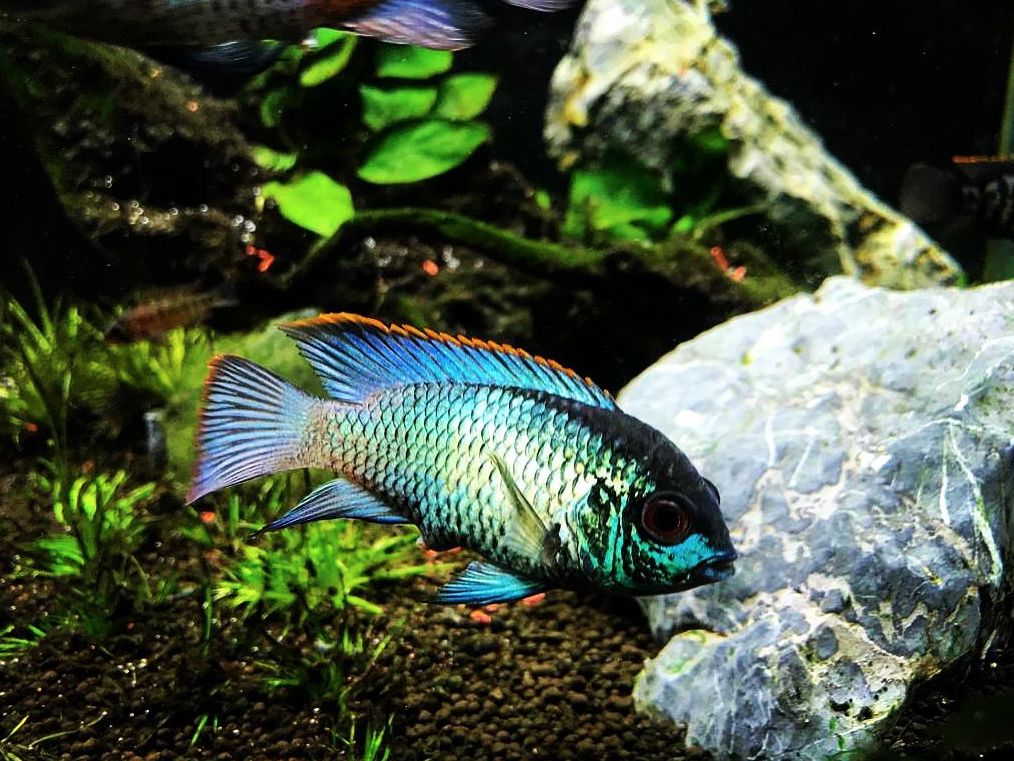
Description
Color
The name of the fish says about its color. The body color is gray and blue with several vertical black bands and sparkles scattered over the body. Blue acaras have a laterally compressed body with a deep oval shape. They display a stunning metallic blue coloration, which intensifies during breeding or when they are excited. The lower parts of their face and belly often have a golden hue. Females tend to have less vibrant colors than males.
Size
The blue acara can grow to an average size of 6-8 inches (15-20 cm) in length when fully mature, although in a tank, they often reach around 6 inches (15 cm). There is some size variation among individuals, with males generally being larger than females. Some males can grow up to 8 inches (20 cm) or even slightly larger.
Blue acaras have an oval-shaped, stocky body with pointed anal and dorsal fins. This robust body shape and the distinct fin structure contribute to their unique appearance and make them well-adapted to their aquatic environment.
Lifespan
The blue acara has an average lifespan of about 8-10 years in captivity. With optimal care, including a well-balanced diet, high water quality, and attentive maintenance, some blue acaras can live even longer. Lifespan can vary due to factors such as genetics, diet, and overall care, so some individuals may live shorter or longer lives.
Fishes typically reach reproductive maturity when they are around 6-6.5 cm in length. Breeding usually begins when the fish grow to about 10 cm. Proper care and a stable environment are crucial during this period to support successful breeding and healthy development.
Difficulties in keeping
The blue acara is an excellent choice for beginner aquarists due to its relatively easy care requirements compared to other cichlid species, such as the green terror. Unlike larger cichlid species that require more substantial tanks, blue acaras don’t grow as large, making them suitable for smaller aquariums.
This cichlid is also not demanding when it comes to feeding or breeding. Blue acaras thrive on a varied diet of high-quality fish food, which includes pellets, flakes, and live or frozen foods. Maintaining proper water parameters and ensuring water purity are crucial for their health. Regular monitoring of water conditions, including temperature, pH, and hardness, will help keep the fish in optimal condition.
In terms of breeding, blue acaras are known for being good and attentive parents, and they generally spawn with relative ease. With proper care, including regular feeding and careful monitoring of water quality, blue acaras make a rewarding choice for those new to keeping cichlids.
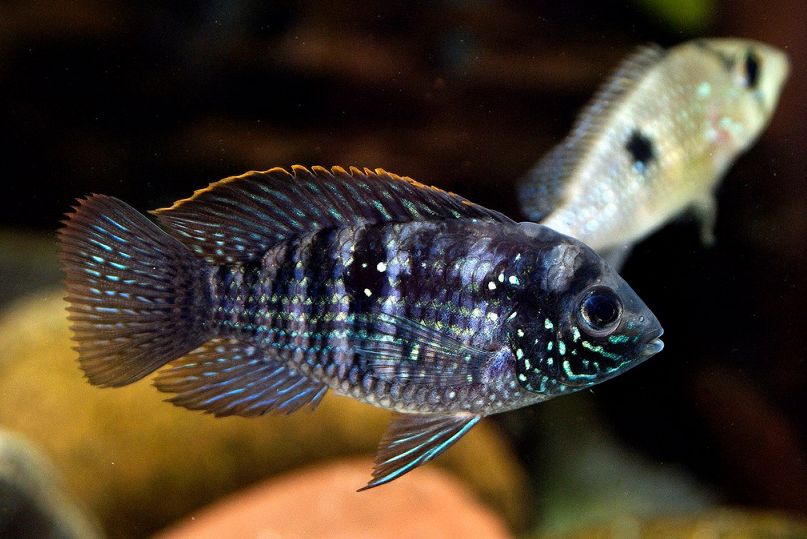
Care and keeping in a tank
Tank size
Blue acaras thrive in a spacious aquarium, which is essential for their well-being and natural behaviors. For a pair of blue acaras, a minimum tank size of 40 gallons (150 liters) is recommended. However, a larger tank, such as 55 gallons (200 liters) or more, is even better as it provides ample swimming space and allows for better territorial establishment.
A larger tank helps reduce stress and aggression, particularly during breeding and territorial disputes. It also offers more opportunities to create hiding spots, such as caves, rocks, and driftwood, which are crucial for the fish’s comfort and security.
In addition to tank volume, consider the dimensions of the aquarium. Blue acaras have a laterally compressed body shape, so a tank with a length of at least 36 inches (90 cm) is preferable. This length supports their swimming and maneuvering needs, allowing them to exhibit their natural behaviors more comfortably.
4o mini
Water parameters
It’s important to renew water and siphonate the tank bottom regularly. Apart from clean water blue acara also likes water flows and it’s better to use good canister filter. The fish adapts to water parameters rather good, but the ideal water parameters for it are the following:
- Blue acaras prefer a water temperature range of 75-82°F (24-28°C). It’s essential to keep the temperature stable within this range to prevent stress or temperature-related illnesses.
- They tolerate a wide pH range but prefer slightly acidic to neutral conditions. Aim for a pH level between 6.5 and 7.5. Avoid extreme pH fluctuations as they can stress the fish.
- Blue acaras are adaptable to a variety of water hardness levels. They can tolerate soft to moderately hard water conditions. Aim for a hardness range of 5-15 dGH (German degrees of hardness).
- It is crucial to maintain low levels of ammonia and nitrite, as these are harmful to fish. Regularly test the water parameters and ensure that both ammonia and nitrite levels are at or near zero. Nitrate should be kept below 20-30 ppm through regular water changes.
It’s also crucial to maintain good water quality, provide proper filtration, and conduct regular water changes to ensure a healthy environment for blue acaras.
Substrate
Fine river sand is better to be used as a tank bottom because cichlid fish likes digging it. It creates a natural-looking bottom and allows the fish to exhibit their natural digging behavior. Fine-grain sand is ideal to prevent any abrasion or injury to the fish.
Therefore, it’s better to put large plants in flowerpots in the tank. Also it’s necessary to create some covers where the fish can hide when it’s stressed.
Dry fallen indian almond leaves and beech can be put on the tank bottom. Besides the fact that they create water parameters close to the ones where fish lives in the wild, they are also source of feed for juveniles.
Decor
Blue acaras appreciate hiding spots and territories to establish their own space. Use rocks, caves, or stacked slate to create caves or overhangs where your fish can retreat, spawn, and establish their territories.
Adding driftwood or root structures can create natural and aesthetically pleasing elements in the aquarium. They provide hiding places and mimic the natural environment of blue acaras. Ensure that the wood is aquarium-safe and won’t leach harmful substances into the water.
Incorporating live plants not only enhances the aesthetics but also provides shelter, oxygenation, and natural filtration. Blue acaras may appreciate plants like Amazon swords, Java ferns, Anubias, and Vallisneria, which offer cover and create a more natural environment. In addition to live plants, you can add floating or submerged vegetation like Hornwort, Water Sprite, or Waterweed.
Diet
Blue acaras are primarily carnivorous and require a diet rich in protein to thrive. In their natural habitat, they feed on worms, larvae, and various spineless species.
In captivity, blue acaras eagerly consume a variety of foods, including bloodworms, tubifex, white worms, and brine shrimp. Frozen foods such as brine shrimp and cyclops are also excellent options, along with high-quality pellets and flakes specifically formulated for cichlids.
A balanced staple diet for blue acaras includes high-quality pellets or flakes that provide a well-rounded blend of proteins, fats, and carbohydrates. It is recommended to feed them a few times a day, offering an amount they can consume within a few minutes each time.
Feeding twice daily with small portions and varying the types of food between morning and evening helps ensure a balanced diet. Monitor their feeding behavior and adjust the quantity as needed to prevent overfeeding and maintain good water quality. Always remove any uneaten food after feeding to avoid water pollution.
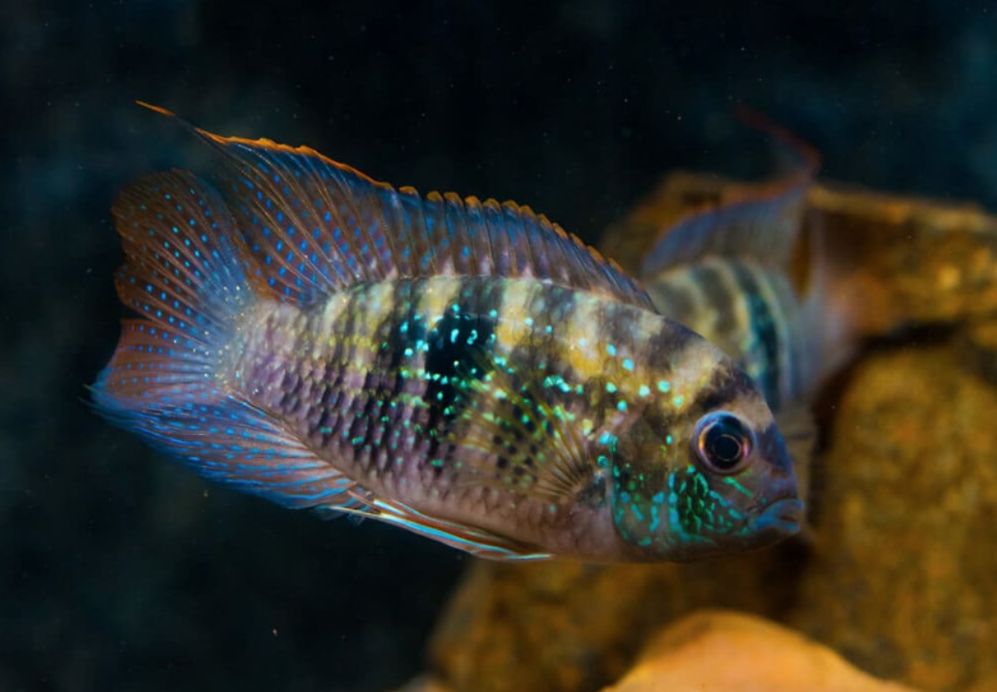
Tank mates
Blue acaras are generally peaceful fish but can become territorial, especially during breeding or if they feel threatened. They are well-suited for community aquariums with other peaceful fish of similar size and temperament. It is best to avoid keeping them with aggressive or overly territorial species, as this can lead to stress and aggression.
Compared to other cichlids, such as the green terror, blue acaras are notably more temperate and less aggressive. They are medium-sized and can coexist with other cichlids, as well as catfish and similarly sized fish.
However, it is important to remember that blue acaras are still cichlids and should not be housed with very small fish, like neon tetras, or with cherry shrimp. Cichlids should be kept with fish of similar size or larger to prevent predation and ensure compatibility.
While blue acaras are generally non-aggressive, they do guard their territory, particularly during spawning periods. Additionally, they enjoy digging in the tank substrate, which can lead to the uprooting of plants.
Best tank mates are: firemouth cichlid, angelfish, convict cichlid, Jack Dempsey cichlid, jaguar cichlid and different catfishes: leopard pleco, plecostomus, bristlenose pleco.
Gender differences: male vs female
Distinguishing between male and female Andinoacara pulcher can be challenging, especially when they are young or not in breeding condition. However, several physical and behavioral traits become more apparent as they mature and approach breeding age.
Physical Differences:
- Size and Coloration: Males are generally larger and more colorful than females. They often have longer, more pointed dorsal and anal fins. Additionally, males may display more vibrant coloration and bold patterns on their fins, particularly during courtship or breeding.
- Fin Structure: Males usually possess elongated filaments and more pronounced fin shapes compared to females.
Behavioral Differences:
- Aggression and Territoriality: Males are known for their territorial nature and may exhibit aggressive behaviors, particularly during breeding. They establish and defend their territory, perform elaborate courtship rituals, and take on the primary role in guarding the eggs and fry.
- Role in Breeding: Females are typically less aggressive and focus on preparing the breeding site and caring for the young. They are involved in nurturing the eggs and fry, while males concentrate on defending the territory.
Both males and females develop darker vertical bands on their bodies when they are breeding or caring for their juveniles. These visual cues help in identifying their breeding condition and involvement in parental care.
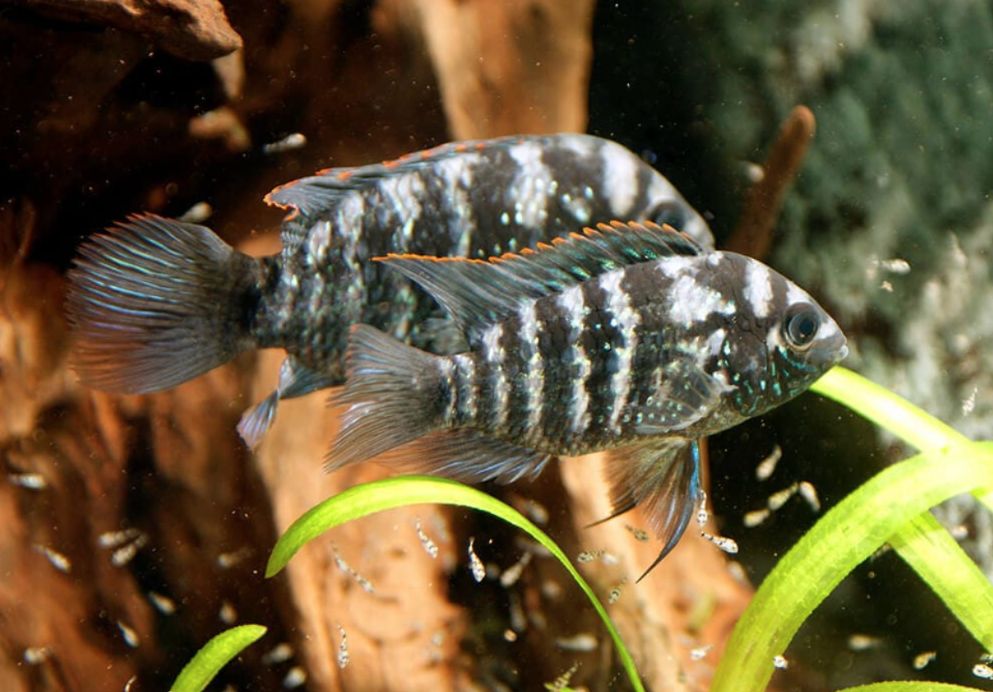
Breeding
This cichlids live rather friendly together and they form couples. Usually they don’t attack other fishes and they scare away their tank mates only if they trespass their territory or during the spawning period.
However, they can spawn each two weeks at the condition that the eggs are taken away right after spawning. Fishes becomes reproductive at the age of 9-11 month. It can spawn in a community tank, but sure it’s better to use a spawning pond for this purpose.
A tank of 100 liters capacity with good aeration will do. It should have some plants. Coarse sand should be used as a tank bottom with big flat rocks, snags on it which lately serve as a substrate for spawning. Water parameters for breeding are: hardness 6-20°, pH 6,5-7,0, temperature 25-28 °C.
Spawning can be stimulated by frequent water renew, high aeration and water temperature increase by 2-3 °C. As it was mentioned above, big flat rocks, flowerpots, snags and pits in the sand (which the fish digs itself) can become a substrate for breeding.
During their spawning period acara becomes aggressive and they intensely guard their territory from tank mates intrusion. Female can lay from 400 to 1000 eggs. Sometimes, the fishes eat their first breed, but later they stop doing it.
Incubation period lasts from 3 to 7 days (depending on the water temperature). After the ich fry appears its parents move it in their mouth into the pits in the sand prepared in advance.
In anoter 3-4 days the juveniles start swimming and feeding. Start feed for juveniles is: freshly hatched brine shrimp, rotifers, nematodes.